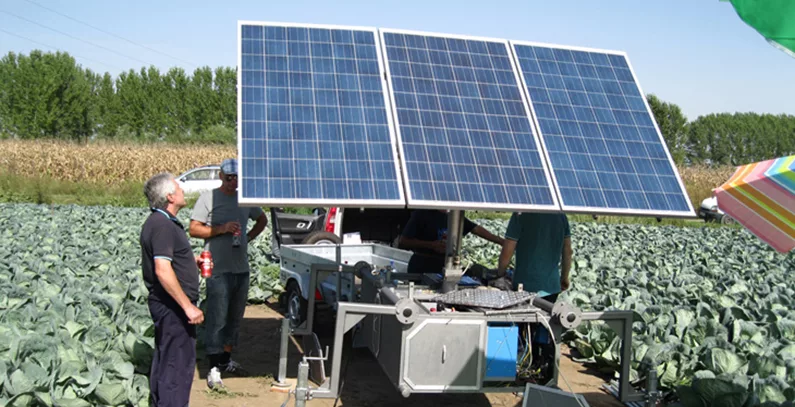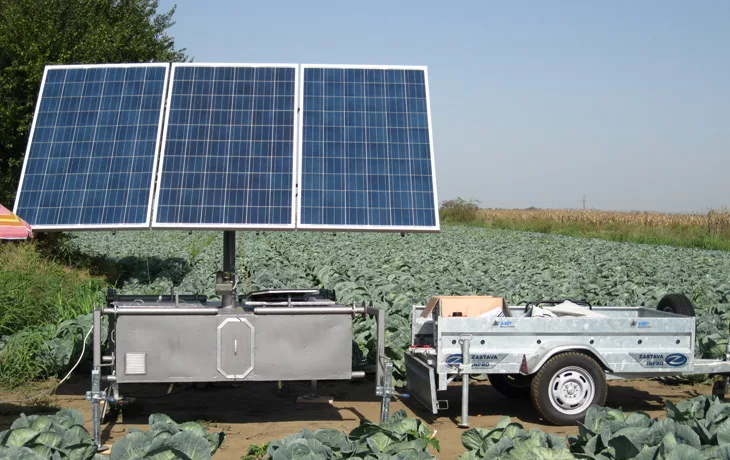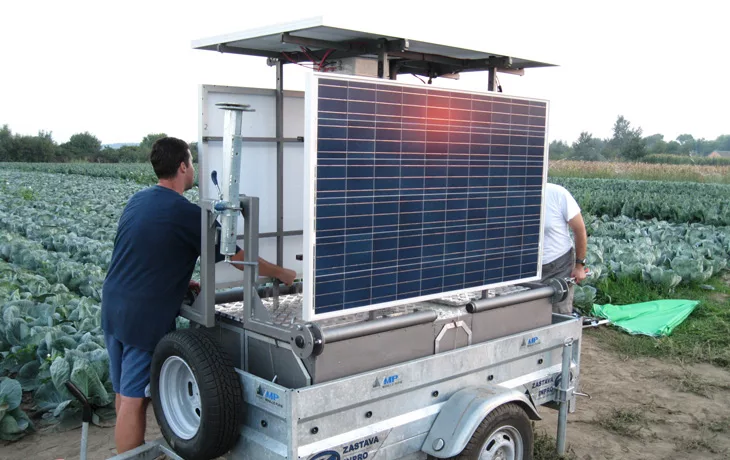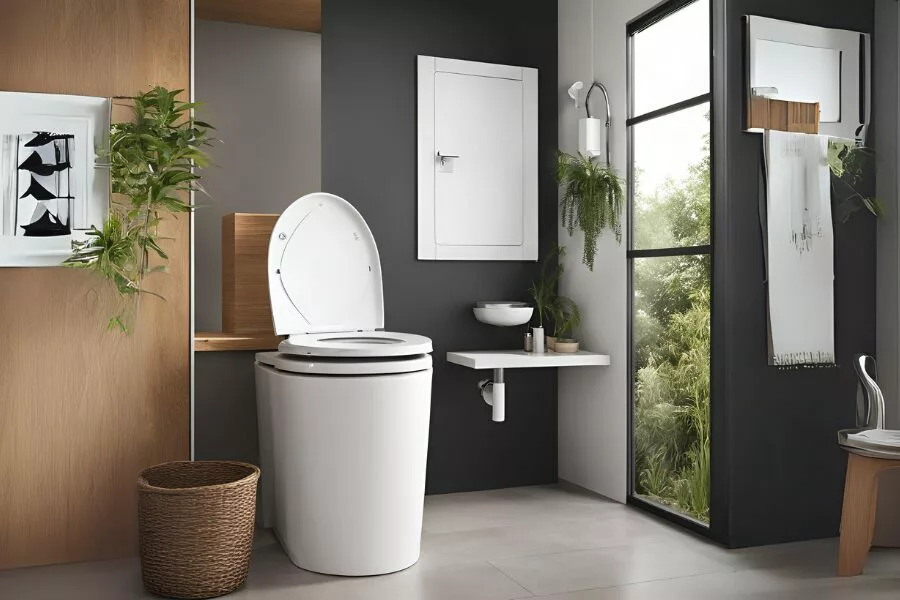We depend heavily on oil, coal, and natural gas, all forms of non-renewable sources of energy that are not clean and emit carbon dioxide and other greenhouse gasses in the environment. A study published shows that around 80 percent of the world’s energy requirement is met by fossil fuel sources. This dependency on carbon-rich fuels has accelerated the triple planetary crisis, climate change being one of them.
To address these triple planetary crises, one of the solutions is to transition towards renewable energy sources like wind, solar, and hydropower. A solar-powered generator is one such innovative solution that harnesses solar energy from the sun and converts it to electrical energy. In this article, we’ll discuss A-Z about a solar-powered generator.

Credits: balkangreenenergynews
1. How does a solar powered generator work?
A solar powered generator works by converting the sun’s energy into electrical energy. It consists of different components that come together and form a portable system that can be used in cases of emergencies when the main power grid is down. These solar powered generators come in different sizes and functions and supply power to various power-dependent devices.
A solar powered generator consists of solar panels, a charge controller, a battery, and an inverter. These are crucial components, and even one missing component will disrupt the whole system.
The process starts when the solar radiations hit the solar panels, which are composed of many small units of photovoltaic cells.
These solar panels convert solar energy into electric energy, but this electricity is in the form of Direct Current (DC) which cannot be used directly. This Direct Current is then directed to the charge controller that stabilizes and regulates the current before storage. Now, the battery bank then stores this energy until it is further needed and then releases it through the inverter in the form of stable Alternate Current (AC).
2. The cost-effectiveness of solar powered generators
At first, you will think that a solar powered generator might not be a cost-effective option because it probably costs more than a fossil fuel generator. A typical solar powered generator can have an average cost of around 2,000 dollars. This varies depending on the size; the smaller solar powered generators can be sufficient to charge cellphones and laptops, while the bigger ones have the capacity to power a small house for a few hours when the power grid is down.
Although you do pay a higher price initially, a solar powered generator does not need much maintenance, and the running of the device is smooth. So, despite the overall initial high cost, you can save on maintenance. They are quiet compared to fossil fuel generators and have fewer moving pieces. And also you don’t have to go and keep buying fuel to run it. After the initial purchase, you don’t need to spend a lot, and they make a good choice since they are portable and are easy to set up.
Unlock Your Savings with Exclusive Offer Coupons
Save big while shopping for sustainable products! Grab your exclusive coupons today!

3. Maintenance and care tips for your solar-powered generator
If you’re the owner of a portable solar-powered generator, then these maintenance tips will come in handy to ensure that the system stays in optimal working condition.
One of the most critical maintenance tasks is to clean the solar panels. With time, dust, debris, and dirt accumulate on the panel, which will reduce the efficiency of the energy generation. So, regularly clean the panels to remove the dust and debris using a soft cloth and a mixture of water, vinegar, or soap.
Check and tighten all the connections in your portable solar powered generator, as movement (traveling or transportation) might loosen the connections over time, affecting the system’s performance.
Batteries can degrade over time, so make sure to keep a check on the battery and inspect it regularly. Start by checking the battery terminals for corrosion, and if you find any wear or tear, clean it up and apply a protective layering to it to prevent further damage.
Keep a regular check on the performance of your solar powered generator, especially on the factors like the battery’s charge level and the system’s voltage. If you notice any irregularities, then it’s a sign that something is wrong. Also, when not in use, make sure the solar-powered generator is stored properly. It will protect the system from damage and will ensure it’s ready to use when needed.
4. Lifespan and durability
The lifespan and durability of a solar-powered generator depend on many different factors, such as the quality of all the components used, the frequency of usage, and the maintenance of the system. If your solar-powered generator is very well maintained, it can last up to 20 years, thus making it a worthwhile investment for your home, weekend getaways, or business.
Also, it is important to know that the lifespan of your solar-powered generator will depend on the type of battery you’re using in the device. Most solar powered generators use durable lithium-ion batteries, which have a longer lifespan of about 10 years with minimal maintenance. Thus, making it an ideal choice for your solar powered generator. Also worth noticing is the fact that the number of charge-discharge cycles that the battery can handle plays a significant role in determining the lifespan of a solar-powered generator.
Not to mention that the quality of the solar panels will prolong the lifespan of a solar-powered generator. High-quality solar panels are made to withstand extreme weather conditions like hail and storms. Thus, when all the components used are of good quality and maintained properly, they will ensure maximum returns on your investments.

5. Portability and use-cases
One thing that makes a solar powered generator a favored choice is that they are portable. They make an excellent choice for outdoor activities like camping or a weekend getaway where you may not have access to fuel. This system also comes in very handy when there are power cuts in the grid and for small DIY backyard projects. Thus, the portability of a solar-powered generator makes it an ideal choice for emergencies.
6. How to choose the right size and capacity
One of the questions you’ll find yourself asking while picking a solar-powered generator is, ‘What size to pick’? This is an important question, as buying the right size will determine that you’ll have an optimal power source by paying only what you should.
Choosing the right size and capacity for a portable solar-powered generator involves considering your power needs, intended usage, available sunlight, and budget. Start by calculating the wattage or kilowatt-hours (kWh) of power you’ll need for the devices you plan to power. Make a list of all the appliances, electronics, and devices you want to run on your solar-powered generator.
For each device, note its power consumption in watts (check labels or manuals). Multiply the power consumption by the number of hours you intend to use the device to determine the daily watt-hour usage. Sum the daily watt-hour usage for all devices to determine the total daily power requirement for your solar generator.
Identify the highest peak load you might have, as this will influence the inverter size and battery capacity needed to handle surges in power usage. Solar panels are not 100% efficient due to factors like weather conditions, shading, and panel orientation. Typically, solar panels are rated in watts. Consider multiplying your total daily watt-hours by a factor (e.g., 1.2) to account for solar panel efficiency.
Divide the adjusted daily watt-hours by the average daily sunlight hours in your location to determine the solar panel size needed in watts. Solar panels are often rated in watts, so choose a solar panel system that meets or exceeds this requirement.
Choose a battery capacity that can store enough energy to meet your needs during cloudy days or when sunlight is limited. Ensure the battery capacity is sufficient to store the energy needed for a day or two without solar charging. Balance power needs with portability. A larger capacity generator will provide more power but may be heavier and less portable. Consider your ability to transport and handle the generator.
Consider your budget for the portable solar-powered generator. Larger capacity and higher-quality components often come at a higher cost. Choose a system that fits your budget while meeting your power needs. When unsure about the calculation, take assistance from an expert who’ll help out with making the right decision.

Credits: balkangreenenergynews
7. The environmental impact
Environmental benefits associated with solar-powered generators are many, thus making it an ideal choice for your home and the environment. Since solar is a renewable source of energy, it produces clean energy harnessed from the sun. Unlike fossil fuels, which generate greenhouse gasses and cause climate change, solar is a cleaner option.
By reducing the need for traditional power generation methods (e.g., coal, oil, gas), solar-powered generators help improve air quality by minimizing harmful air pollutants and particulate matter. Additionally, solar power does not require water for operation, reducing water usage and pollution associated with traditional power plants. Numerous other benefits are related to the usage of solar-powered generators, which you can read about here.
8. Common myths debunked
Myth-1 Solar power is expensive
Solar energy is now affordable for homeowners thanks to decreased installation costs. The initial investment can be recouped within 5-10 years through reduced electricity bills, and the solar system can provide free electricity for 20-30 years.
Myth-2 Solar Panels Operate only during sunny weather
Solar panels can generate electricity through the sun’s ultraviolet rays, even on cloudy days. They are more efficient in cooler temperatures, allowing countries with less sun exposure to still utilize solar energy. Despite its cloudy weather, Germany generated over 50% of the world’s solar energy in June 2014.
Myth-3 Solar Panels are complicated to install and maintain
When it comes to installing solar panels, it is vital to choose a manufacturer that is trustworthy and reliable. This step is crucial to ensure the longevity of the system and its ability to produce ample amounts of energy.
The panels are designed with robust construction, allowing them to endure harsh weather conditions such as sleet, hail, and more while functioning effectively. However, it is recommended to occasionally clean the panels with water to eliminate any dirt, debris, or dust that may have accumulated over time.
9. Future innovations and advancements to watch out for
The ongoing global discussions on climate change and environmental concerns have intensified the quest for alternative energy sources. The need for renewable energy has led to the increasing popularity of solar power as a feasible solution for our energy requirements. As technology develops and advances, solar generators are expected to play a more significant role in providing power for our daily needs, whether at home or on the move.

Ecowiser Take on Solar Powered Generator
Understanding solar-powered generators is pivotal for a sustainable future. Solar generators provide clean, renewable energy, reducing reliance on fossil fuels and mitigating climate change. Efficient use of solar power can lower electricity costs and enhance energy independence. It’s essential to grasp system design, sizing, and maintenance for optimal performance, ensuring long-term environmental benefits. Educating individuals and communities about solar technology fosters widespread adoption and contributes to a greener, more sustainable world.
Explore our Home & Lifestyle blogs for deeper insights into solar energy and elevate your sustainable living journey!
Want to read more like this?
Get similar stories and a free sustainability checklist delivered to your inbox.

Like our content?
Get similar stories and a free sustainability checklist delivered to your inbox.















